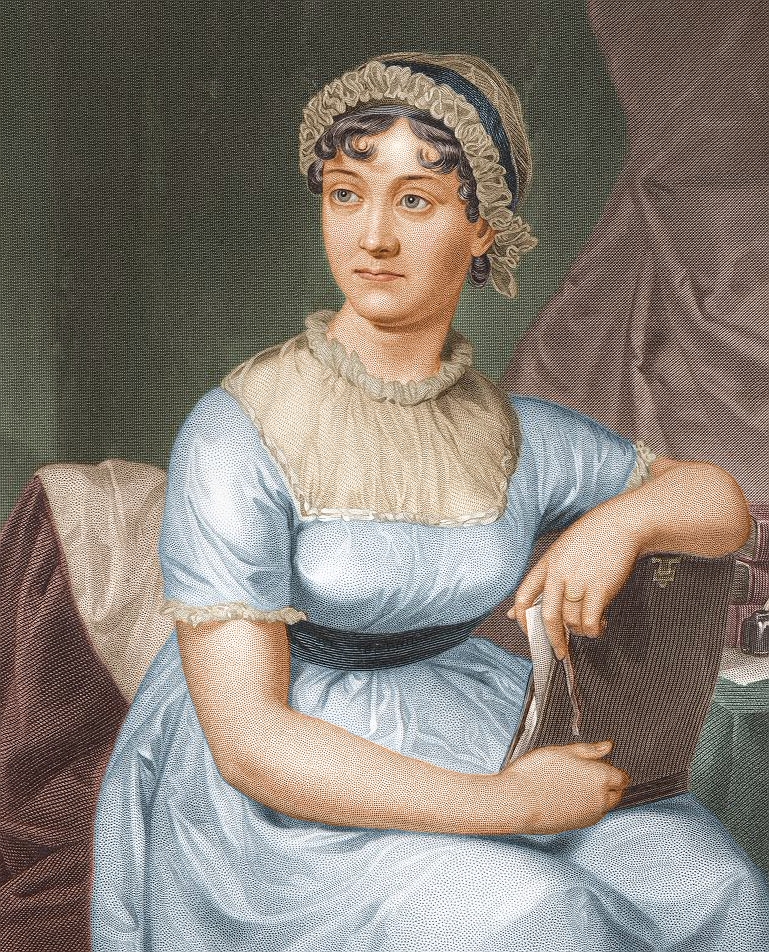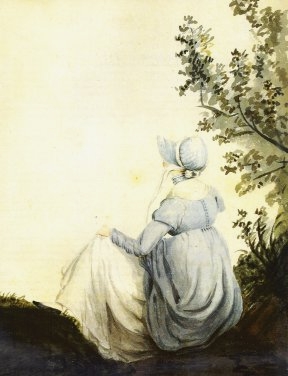
Jane Austen (1775-1817)
On December 16, 1775, English novelist Jane Austen was born. She is considered to be one of the most widely read writers in English literature. I do really appreciate Jane Austen’s novels, esp. her famous ‘Pride and Prejudice‘ and also ‘Emma‘ or ‘Nothanger Abbey‘ which all of them I can recommend to you if you haven’t read them up to now. I personally like Jane Austen’s style of narration, always with a little twinkle in her eye, but nevertheless always exposing biting social commentary.
“It is a truth universally acknowledged, that a single man in possession of a good fortune, must be in want of a wife. However little known the feelings or views of such a man may be on his first entering a neighbourhood, this truth is so well fixed in the minds of the surrounding families, that he is considered the rightful property of some one or other of their daughters.”
– Jane Austen, Pride and Prejudice, 1813
Jane Austen – Early Years
Jane Austen was born on December 16, 1775, at Stevenston rectory near Basingstoke, in Hampshire, among a family of six brothers and one sister to Reverend George and Cassandra Austen, a family of the lower ranks of the landed gentry. The family was well educated and well-read, so that the young Jane Austen was comparatively well supported for her time as a girl and enjoyed a relatively comprehensive education. She had free access to her father’s library, was educated mainly at home and never lived apart from her family. She had a happy childhood amongst all her brothers and the other boys who lodged with the family and whom Mr Austen tutored. To amuse themselves, the Austen children wrote and performed plays and charades, and even as a little girl Jane was encouraged to write. In order to acquire a more formal education, Jane and her older sister Cassandra were sent to boarding schools in 1783. During this time, Jane and her sister caught typhus, with Jane nearly succumbing to the illness.
Becoming an Author
Since her father encouraged her interest in literature at an early age, she came into contact with a large number of well-known works at an early age. Her main focus was on the publications of William Cowper, Alexander Pope, Henry Fielding [5] and George Crabbe, which she also quoted in her works. Ever fascinated by the world of novels and stories, Jane began to write in bound notebooks and at age 14 she started to craft her own novels and wrote “Love and Freindship”, a parody of romantic fiction organized as a series of love letters. Using that framework, she unveiled her wit and dislike of sensibility, or romantic hysteria, a distinct perspective that would eventually characterize much of her later writing. In 1795, Austen met Tom Lefroy, the nephew of their neighbors at Steventon. He had just finished a university degree and was moving to London to train as a barrister. According to her letters to Cassandra, Austen spent a great deal of time with Tom Lefroy and may have had romantic feelings for him. Unfortunately, a marriage between the two was impractical, and LeFroy’s family soon sent him away. After her brief romance with Lefroy, Austen began to work on a novel entitles “First Impressions”, which would later become “Pride and Prejudice”. Austen then began a serious revision of her the initial sketches for “Sense and Sensibility”, as well as working on a satire on the Gothic literary genre called “Northanger Abbey”, where her own delight in reading and her ironic mocking of its impact on young girls comes very much alive.

Watercolour of Jane Austen by her sister, Cassandra, 1804
Moving to Bath
“One cannot fix one’s eyes on the commonest natural production without finding food for a rambling fancy.”
~ Jane Austen, Mansfield Park, 1814
After Reverend Austen announced his retirement from the ministry in 1801 the Austen family moved to Bath. Austen’s mixed feelings about moving from her childhood home was clear by her sudden lack of productivity as a writer. Little is known about this stage of their lives, as almost all letters from this period have been lost or destroyed by family members. Since Jane Austen was critical of the move to Bath from the beginning, it can be assumed that she was not very happy there. She also probably worked little as a writer during this time. Only the novel fragment The Watsons is mostly assigned to this period.While in Bath, Jane received her only marriage proposal: from Harris Bigg-Wither, the younger brother of family friends and an Oxford graduate six years her junior. Although he was apparently unremarkable both physically and intellectually, his considerable fortune made him an attractive bachelor. Austen accepted initially, but changed her mind the following day and rescinded her promise. For Austen, turning down the marriage proposal was a significant decision, since marriage would have freed her from the embarrassing situation of being dependent on her family.
And moving on to Chawton
After the death of her father in 1805, Jane Austen, her mother and sister first moved with their brother Francis and his wife to Southampton, where they lived until 1809. In 1809 they moved together with their friend Martha Lloyd to Chawton, where their brother Edward (1767-1852), who had been adopted by a rich uncle, offered them a small country house on his estate in Chawton. Jane Austen lived there until her death and revised, wrote and published all her novels. Through her brother Henry, the publisher Thomas Egerton agreed to publish “Sense and Sensibility” ,which appeared in October 1811. Austen’s heroines are determined to marry wisely and well, but romantic Marianne of Sense and Sensibility is a character, who feels intensely about everything and loses her heart to an irresponsible seducer. “I could not be happy with a man whose taste did not in every point coincide with my own. He must enter into all my feelings; the same with books, the same music must charm us both.“
The End
As an established novelist she lived in relative seclusion and finally became seriously ill at the age of 40. Today it is believed that she suffered from adrenocortical insufficiency, the cause of which was unknown at the time and for which there was no treatment. She travelled to Winchester with her sister Cassandra on 24 May 1817 to seek healing, but died there on 18 July and was buried in Winchester Cathedral on 24 July, 1817. And, even though Austen passed away at the early age, her novels remain an intricate part of any academic study program of English Literature. And, many of her novels have become successful movies. Jane Austen published anonymously throughout her life, the books always carried the author’s name “by a lady”, even though the author’s identity became more and more an open secret over time.
![One of the first two published illustrations of Pride and Prejudice, from the Richard Bentley edition.[155] Caption reads: "She then told him [Mr Bennett] what Mr Darcy had voluntarily done for Lydia. He heard her with astonishment."](http://scihi.org/wp-content/uploads/2012/12/800px-Pickering_-_Greatbatch_-_Jane_Austen_-_Pride_and_Prejudice_-_She_then_told_him_what_Mr._Darcy_had_voluntarily_done_for_Lydia-388x650.jpg)
One of the first two published illustrations of Pride and Prejudice, from the Richard Bentley edition.[155] Caption reads: “She then told him [Mr Bennett] what Mr Darcy had voluntarily done for Lydia. He heard her with astonishment.”
Jane Austen’s Legacy
“The person, be it gentleman or lady, who has not pleasure in a good novel, must be intolerably stupid.”
– Jane Austen, Northanger Abbey, 1817
Jane Austen’s novels reach beyond the “romantic love story” in their meaning and have achieved a similar cultural status in English-speaking culture, especially British culture, to William Shakespeare‘s comedies.[6] In their linguistic virtuosity and economy, Austen has often been compared by literary critics to the playwright. Jane Austen’s main talent was her astute observation of human nature and social interactions. One of the pioneering stylistic developments is the speech she experienced, which was introduced as a literary stylistic device at the end of the 18th century and decisively further developed by Jane Austen.
Belinda Black, Jane Austen, Persuasion: Irony and the Mysterious Vagaries of Narrative, [11]
References and further Reading:
- [1] Jane Austen at biographyonline.net
- [2] Jane Austen at biography.com
- [3] Writings of Jane Austen at gutenberg.org
- [4] James Edward Austen-Leigh: A Memoir of Jane Austen (at gutenberg.org)
- [5] Henry Fielding – the Father of the English Novel, SciHi Blog
- [6] Brush Up Your Shakespeare, SciHi Blog
- [7] Jane Austen’s Fiction Manuscripts Digital Edition, a digital archive from the University of Oxford
- [8] A Memoir of Jane Austen by James Edward Austen-Leigh
- [9] Works by or about Jane Austen at Internet Archive
- [10] Jane Austen at Wikidata
- [11] Belinda Black, Jane Austen, Persuasion: Irony and the Mysterious Vagaries of Narrative, Gresham College @ youtube
- [12] Timeline for Jane Austen, via Wikidata





